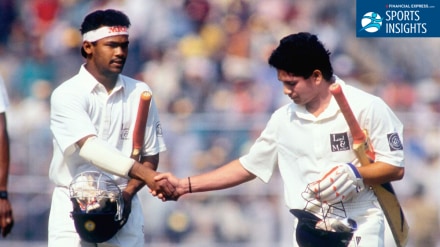Every Indian kid who’s ever held a cricket bat knows the name Sachin Tendulkar. But not everyone remembers the other boy who stood beside him when the world first noticed that 664-run partnership – Vinod Kambli.
Two boys from the same school, under the same coach, sharing the same dream. One became the “God of Cricket.” The other, a reminder that talent alone is never enough.
The Boys from Shardashram
In the late 1980s, Mumbai’s Shivaji Park was the nursery of Indian cricket. Coach Ramakant Achrekar’s whistle ruled those mornings. Among his wards were two boys – Sachin Ramesh Tendulkar from Bandra, and Vinod Ganpat Kambli from Kanjurmarg.
Kambli came from a small chawl, his father a mechanic struggling to feed seven mouths. Yet, every day, Vinod would lug his cricket kit through packed local trains to the nets. He played with the hunger of a boy who wanted to change his life.
That hunger met Sachin’s discipline. Together, they became unstoppable. The day they stitched 664 runs for Shardashram Vidyamandir, the school ground turned into a carnival. Kambli made 349 of them – and then, as if that wasn’t enough, picked six wickets for 37 runs. Two kids, one dream, and a friendship that looked unbreakable.
The Stairs and the Elevator
Kambli once said, “Sachin took the elevator. I took the stairs.”
It sounded like a clever line, but behind it was a deeper truth.
While Sachin debuted against Pakistan at 16, Kambli had to wait three more years. When he finally got his chance, he exploded. Two double centuries – one against England in Mumbai, another against Zimbabwe soon after. In his first seven Tests, he scored 793 runs at average of 113.2.
He looked like India’s next big thing. A left-hander with flair, power, and audacity. Bowlers feared his cuts and drives. Shane Warne once got smashed for 22 runs in an over by him.
But Indian cricket, at that time, was not ready for someone like Vinod Kambli.
Fall That Everyone Saw Coming
Kambli played 17 Tests. Scored 1084 runs with 54.2 average. The highest by any Indian who’s crossed a thousand runs in Tests. Yet, he was dropped – and never came back.
The reasons? Many said he struggled against the short ball. Others whispered about his lifestyle – the gold chains, the late nights, the attitude that didn’t sit well with selectors. Indian cricket, still conservative then, preferred quiet gentlemen over flashy rebels.
But there was something deeper too. Kambli came from the kind of background where survival itself is a fight. Fame hit him like a flood – fast, loud, overwhelming. And he never learned to swim in it.
When the lights dimmed, the cameras turned away, and the phone stopped ringing, he didn’t know what to do. He once cried on live TV after India’s loss in the 1996 World Cup semifinal. People mocked him, but few realized that at that moment, his ODI average was higher than Tendulkar’s, Azhar’s, or Jadeja’s.
That day, when he walked off the Eden Gardens field in tears, he was still one of the best ODI batter of India statistically. But numbers don’t always save you from being forgotten.
Shadow of Sachin
For all his life, Kambli was compared to Tendulkar. It was never a fair fight. Sachin was calm, composed, and focused. Kambli was emotional, impulsive, restless.
And yet, both loved each other like brothers.
When Kambli suffered two heart attacks in 2013, it was Sachin who quietly paid his medical bills. But years earlier, in 2009, their bond had cracked. Kambli, frustrated and bitter, said on a reality show that Sachin “could have helped him more.” It hurt both of them deeply. Sachin never mentioned him in his retirement speech. For three years, they didn’t speak.
Later, Kambli admitted he’d said those words in anger. “It was frustration. I didn’t mean it. I called him. Childhood friendship came through again.”
Eventually, Tendulkar offered him a role at his Middlesex Global Academy. Old wounds healed, if not forgotten.
Forgotten Numbers
Kambli’s numbers still speak loudly for him.
In Tests: 1084 runs at 54.2 average. Still highest among all Indian batters with 1000 runs.
In ODIs: 2477 runs at 32.59 average, but at the end of 1996 World Cup, he averaged 40.78, 2nd highest batting average among all Indian batters at that time.
In first-class cricket: 9965 runs at 59.67 average – a mark only five players in the world have bettered.
These are not numbers of a failure. They’re the numbers of a man who burned bright but short.
Beyond Cricket
After cricket, Kambli tried everything – acting in films like Anarth and Pal Pal Dil Ke Saath, commentary, even politics. But nothing fit quite right. He once played in South Africa’s domestic league for Boland, still chasing a comeback at 30.
He never stopped believing he could return. That belief, misguided or not, was the only thing that stayed constant.
Boy Who Needed More Than Talent
Vinod Kambli’s story isn’t about wasted potential. It’s about how talent alone can’t carry you when the world demands something else – composure, diplomacy, restraint.
He didn’t have the system behind him. He didn’t have the cushion of privilege. What he had was heart, emotion, and a bit of chaos.
Sachin and Vinod – two sides of the same dream. One became the symbol of perfection. The other became a lesson in what happens when life takes a turn too early.
Yet, somewhere in the crowded local trains of Mumbai, maybe there’s another kid with a torn kit bag, dreaming of a 664-run partnership. And for that dream, both Sachin and Vinod matter equally.
